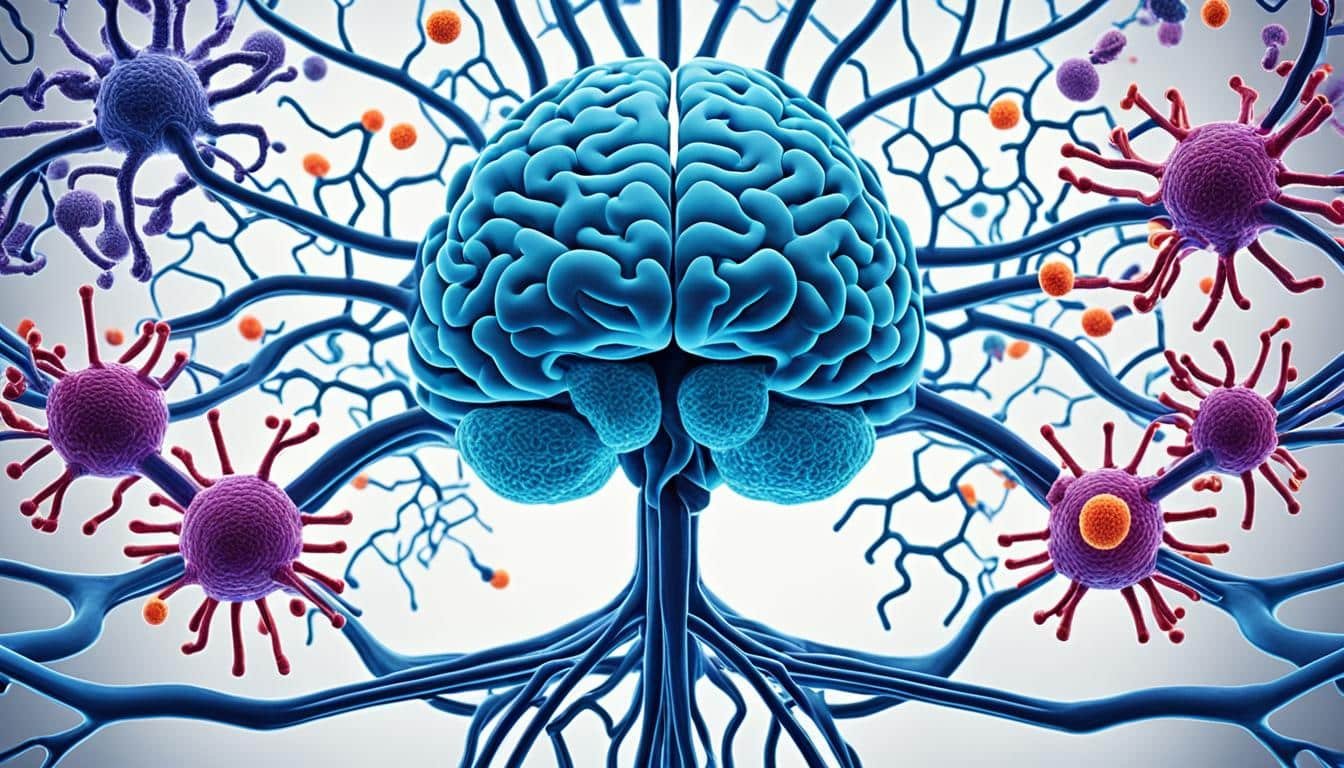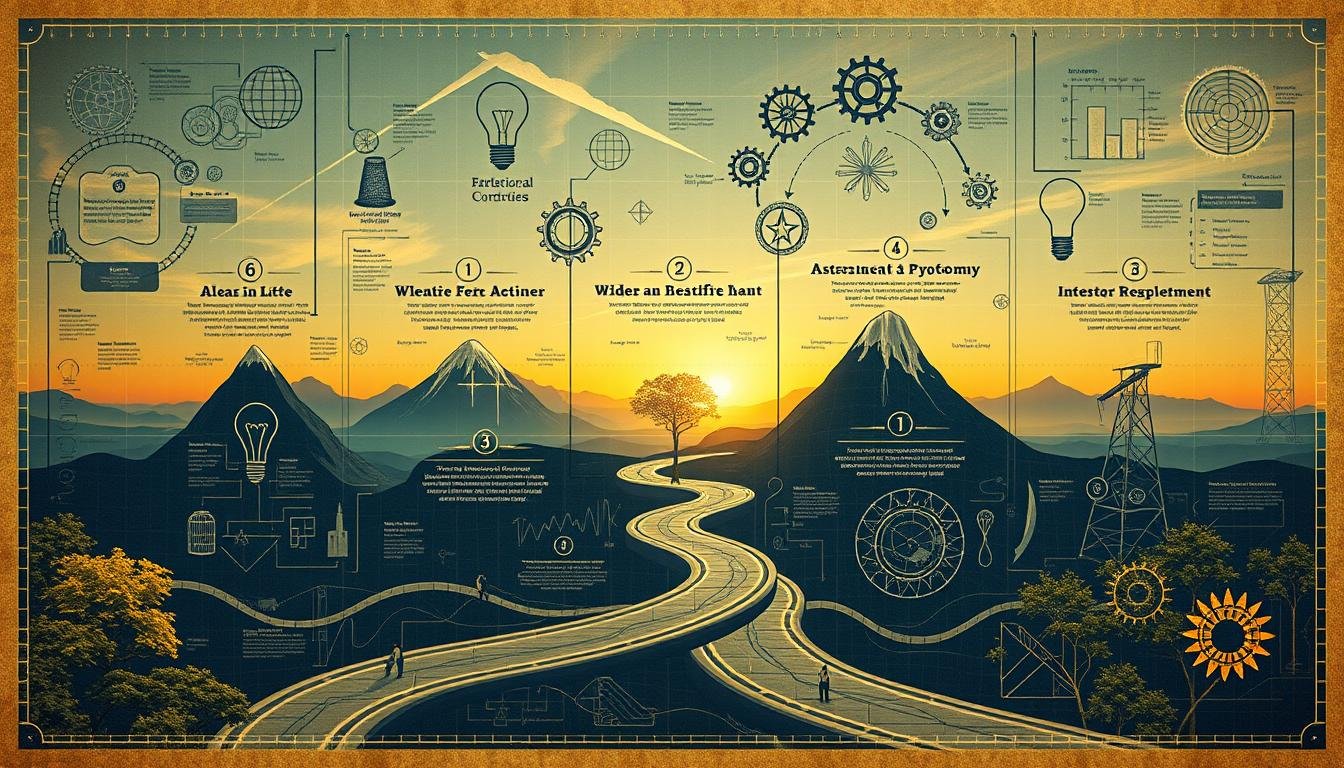Embodied cognition is a growing field that questions the old idea that our thoughts are just in our heads. It shows how our body and its actions help shape our thinking1. This idea is supported by studies that show our senses and muscles play a big part in how we think and act1.
Our body and how we interact with the world greatly affect our thinking. This view gives us a new way to see how our mind and body work together1. It’s like understanding the embodied mind better.
Studies show that our body’s actions can change how we think and see things. For example, holding a soft ball made people think faces were more female2. Holding a hot cup of coffee made someone seem more trustworthy2. These examples show how our body’s feelings affect our thoughts and how we see others.
Even our posture can change how we see things. In one study, students who leaned to the left thought objects were smaller than those who sat straight3. This shows how our body and mind work together closely, proving that thinking isn’t just in our heads.
Embodied cognition comes from many fields like psychology and philosophy1. It’s about understanding how our body and the world around us shape our thoughts. This view is different from the old idea that thinking is just about numbers and rules.
Key Takeaways
- Embodied cognition shows how our body and the world shape our thinking.
- Studies have found that our senses and muscles play a big part in thinking.
- Things like posture and touch can change how we think and see others.
- This idea comes from many fields and offers a new view of the mind and body.
- It challenges the old idea that thinking is just about numbers and rules.
Introduction to Embodied Cognition
Embodied cognition is a field that looks at how our body affects our thinking. It says our mind isn’t just in our head but is linked to our body and the world. Studies show our body shapes how we think4. Researchers from many fields like science and psychology find this very interesting.
Defining Embodied Cognition
Embodied cognition believes our thoughts come from our body and how we interact with things. It says our mind and body work together, not apart. This idea raises questions like if left-handers see the world differently than right-handers4. Experts like Arthur Glenberg have studied this a lot4.
Philosophers have been thinking about this idea for a while. They wondered how we know things and how our mind stores that knowledge4. Some think our mind helps our body and meets its needs4. This fits with embodied cognition, which says our body affects how we think.
Traditional Views of Cognition vs. Embodied Cognition
Older views of the mind see it as a computer, with the brain as the main part5. Embodied cognition says this isn’t the whole story. Ecological psychology, by J.J. Gibson, goes against this idea5.
Connectionist psychology also questions this view5. Researchers look at many ideas, including the work of Merleau-Ponty4. They talk a lot about different views on embodied cognition4.
Embodied cognitive science and radical embodied cognitive science differ on one key point: internal representations4. Cognitive psychologists focus on how our brain works and what it represents4. They try to understand how our body, mind, and environment work together.
The Body’s Role in Cognition

Embodied cognition is a theory that links our body’s experiences to our thoughts. It says that our knowledge comes from our body and senses. This idea is new but has been tested for years6. It shows how our mind and body work together, changing how we think about thinking7.
Sensory-Motor Experiences and Cognitive Processing
Embodied cognition says our thoughts rely on our brain’s sensory-motor system. This system brings back past experiences through sensory-motor simulation. When we recall an experience, our brain re-acts like it did during the original event. This shows how our body and mind work together to shape our thoughts and reasoning7.
Studies show how our senses affect our thinking. For example, holding a warm cup of coffee makes us feel closer to our family6. Also, being smart might be linked to how much we use our senses in our daily lives8.
The Significance of the Physical Body in Shaping the Mind
Embodied cognition highlights the body’s role in our thinking. It challenges the old idea that our mind can work on its own7. This new view says our body and mind are connected, not separate7.
This approach looks at how our body affects our thinking. It suggests that our body is key to how we think, not just a place for information storage6.
| Traditional Views of Cognition | Embodied Cognition |
|---|---|
| Cognition is abstract and symbolic | Cognition is grounded in sensory-motor experiences |
| Mind and body are separate entities | Mind and body are interconnected |
| Cognitive processes occur in the brain alone | Cognitive processes involve the entire body |
The idea of embodied cognition challenges the old view of thinking7. Maurice Merleau-Ponty’s work supports this idea with examples of how our body shapes our thoughts and language7.
Grounding Abstract Concepts in Concrete Experiences
The embodied cognition framework says abstract concepts come from concrete experiences. It uses metaphorical mapping and situational representations. This means our complex experiences shape how we understand abstract words and concepts9. Language helps us learn abstract concepts indirectly, showing the difference between concrete and abstract ideas10.
Metaphorical Associations between Abstract Concepts and Concrete Domains
Metaphors link abstract concepts to concrete things, helping us grasp them. For example, power is seen as being up high, with the higher person seen as more powerful11. This way, we relate abstract ideas to things we can touch and feel.
Studies using brain scans show that our brains process both concrete and abstract ideas together9. The brain areas more active for abstract ideas include parts linked to our interactions with the world9.
Indirect Grounding of Abstract Concepts through Sensory-Motor Experiences
Abstract concepts don’t always have a direct link to our senses or actions. But, they can be indirectly linked through metaphors and how we see things. Research shows that our brain’s sensory and motor areas are linked to understanding concrete language9. This means abstract ideas can be understood by linking them to concrete experiences and simulations.
Creating visual images for abstract concepts can be easier for some than others, depending on what they mean to us11. A study had people think of visual images for abstract concepts like power and draw them. The results showed that images for more powerful concepts were higher up, like in previous studies11.
The embodied cognition framework and the idea of grounding help us learn abstract concepts through our senses and metaphors10. By linking abstract ideas to real experiences, we can better understand and process abstract language and thoughts.
Orientational Metaphors and Spatial Representations

Orientational metaphors help us understand complex ideas by linking them to our spatial experiences. They give us a way to picture abstract concepts as being up-down, left-right, or front-back. These metaphors are everywhere in language and thought, making complex ideas easier to grasp by relating them to what we know well12.
Vertical, Horizontal, and Sagittal Metaphors
Vertical metaphors are very common. They link positive or powerful ideas with going up and negative or weaker ideas with going down. Phrases like “feeling up” or “hitting rock bottom” show this. Studies show that power is linked to being up, affecting how fast people react when they see a powerful group above them13.
Horizontal metaphors are about time or progress. We say “moving forward” or “taking a step back” to talk about life changes. Sagittal metaphors use front-back to talk about moving forward or backward in time, with the future ahead and the past behind.
Physical Basis for Orientational Metaphors
Many orientational metaphors come from our body and how we interact with the world. For example, “more is up” comes from stacking things vertically showing more quantity. This idea is so strong in our minds that it affects how we understand texts that go against it, making it harder to process13.
Metaphors like “power is up” also have a physical link, from our experiences of power coming from someone above. People with strong personalities tend to use the vertical space more, reacting faster in certain tests13. This shows how our body and the world shape how we think about abstract ideas through these metaphors.
Orientational metaphors also affect how we remember things and make decisions. They influence our memory and decision-making. For example, how we remember positive or negative things can depend on where they are on the screen13. Moving marbles in certain ways can also bring up memories of good or bad times13.
In conclusion, orientational metaphors are a key way to connect abstract ideas to our real experiences. By understanding how these metaphors work, we can see how our body and experiences shape our thinking.
Embodied Cognition and Emotions
Our bodies and emotions are closely linked, thanks to embodied cognition. How we move and interact with the world affects our thoughts and feelings. Embodied cognition helps us see how our physical world shapes our emotional lives.
Emotional Metaphors and Bodily Experiences
Emotional metaphors help us understand and express feelings. They often come from our body’s sensations. For instance, we might say happiness feels “light” or “uplifted,” while sadness feels “heavy” or “down.”
This link between emotions and vertical motion comes from our physical experiences. Studies show that moving marbles up or down can make us think of positive or negative memories14. This shows how our body movements affect our emotional memories.
The Influence of Movement on Emotional Memories
Our body movements can change how we feel and remember things. Research shows that certain postures or movements can change our mood and how we think.
In one study, 48 participants were split into three groups. Each group had 16 people, with 12 left out for not keeping the facial expressions14. The average age was 20.46 years, with a standard deviation of 2.19 years14. The study used a mix of experimental designs to test how facial expressions and emotions change over time14.
The study looked at scores and reaction times from tests like the IPANAT and PANAS, both measured twice14. The IPANAT has 36 entries to check how words feel emotionally14. To induce emotions, participants watched videos that made them feel certain ways14.
The results show that our facial expressions and movements can change how we remember and feel emotions. By doing certain physical actions, we can change our emotional state and how we recall past events.
Knowing how emotions are linked to our body can help us manage our feelings better. By choosing to move in ways that make us feel good, we can improve our emotional experiences and memories. This idea is important for psychology, therapy, and personal growth.
Cultural Differences in Embodied Cognition

As a copywriter, I’ve learned how big of an impact cultural differences have on how we think with our bodies. Different cultures use their bodies in unique ways, affecting how often and when they feel certain feelings15. For example, Maleej’s 2004 study showed that people express anger in three main ways: through their body, in ways specific to their culture, and in ways influenced by their culture15.
Language shows a big difference in how people think about abstract ideas like time, depending on their culture. Mandarin speakers use vertical terms for time and react quicker to vertical time representations than English speakers, who think of time as horizontal16. This shows how important it is to consider individual differences and context when looking at how language works16.
Even though people worldwide have similar bodies, they use them in different ways; behaviors like walking, eating, standing, and washing vary a lot.
The environment we live in also shapes our culture, identity, and behavior17. Old buildings show us how different cultures use materials, shapes, seating, and textures to reflect their unique identities17. These differences in how people use their bodies, like in gestures and personal space, are seen all over the world17.
Knowing about these cultural differences in how we use our bodies is key to better communication and working together across cultures. By understanding how people from different cultures express themselves and interact with their world, we can build more empathy, respect, and understanding in our global community.
| Culture | Language | Time Representation |
|---|---|---|
| Mandarin | Vertical terms for time | Faster response to vertical representations |
| English | Horizontal terms for time | Faster response to horizontal representations |
As we learn more about embodied cognition, it’s important to see it in the context of culture. Cultural practices and norms deeply affect how people think and act15. By valuing cultural diversity and seeing how our physical experiences shape our thoughts, we can understand the human mind better and the rich experiences we all have.
The Role of Gestures in Understanding and Memory
Gestures are more than just simple movements. They play a big part in how we understand and remember things. People everywhere use gestures, showing they are a key part of talking to each other18. Even people who have never seen gestures use them, proving it’s not just about seeing them18.
Many think gestures are less important than speaking, but they’re crucial for communication18. Studies show that combining speech and gesture helps us understand each other better18. The Growth Point Theory suggests that speech and gesture come from the same system, showing they work together in our minds and when others see them18.
Gestures as Facilitators of Comprehension
Gestures help us understand complex ideas better. A study in Australia found students did better on quizzes when they used gestures, especially for learning about Brownian motion19. This shows how important gestures are for learning and how they help students do well19. Gestures are great for explaining things that involve seeing and moving, which speech often can’t do18.
The Impact of Gestures on Memory Formation
Gestures help us remember things too. A study from 1981 showed that people remember actions better than just words20. This effect helps us remember actions we or others did20. Another study in 2010 found that gestures make learning and remembering easier20.
| Study | Key Findings |
|---|---|
| Cohen (1981) | Participants more likely to remember self- or subject-performed tasks than verbal tasks20 |
| Cook et al. (2010) | Recall rates higher for vignettes associated with gesturing20 |
| Australian study on Brownian motion | Significant improvement in quiz scores for students who used meaningful gestures19 |
We need more research to learn how to use gestures in teaching effectively19. Some worry that gestures might become too popular in schools without knowing how to use them right19. The study showed gestures work well for learning about certain topics, but we’re not sure about others19.
Gesture is known to facilitate cognitive formation of messages, support learning and memory, and enrich the communicative context18.
In conclusion, gestures are key to understanding and remembering things. They help us grasp complex ideas and keep information in our minds. As we learn more about how our bodies and minds work together, we see how important our movements are to thinking and learning.
Posture and Cognitive Processes

Our body position greatly affects our thinking, feelings, and mental health. Studies show that standing tall can make us more focused, confident, and happy than slouching21. In a study, 82 young adults found that standing tall made them feel better and think faster than slouching21.
Our bodies influence our minds, known as embodied cognition. A study had people remember past events while in certain positions22. They recalled memories better when their body matched the memory’s setting22.
Memories came back faster and were remembered better when the body was in the right position22. This shows how our posture affects our memory and thinking22.
| Posture | Effect on Cognition |
|---|---|
| Open, upright postures | Enhanced attention, confidence, and mood |
| Slouched or stooped postures | Decreased attention, confidence, and mood |
| Congruent postures during memory retrieval | Faster response times and better long-term retention |
| Incongruent postures during memory retrieval | Slower response times and poorer long-term retention |
These findings are important. They show how our posture affects our thinking and mental health22. By standing tall, we can improve our thinking, mood, and mental performance.
“We must appreciate how our bodies shape our minds and recognize the power of embodied cognition in our daily lives.”
Embodied Cognition in Language and Communication
Embodied cognition greatly affects how we use language and communicate. Our experiences and how we interact with the world shape our language. This includes how we understand and talk about abstract ideas. Studies show that how parents talk to their kids is linked to their language skills23. Also, a program where parents talk more with their kids helps improve their language skills23.
Embodied Metaphors in Language
Embodied metaphors help us connect abstract ideas to real experiences. For example, saying we feel “light-hearted” uses the feeling of being light to describe happiness. These metaphors come from our body’s experiences. Research shows that how parents talk early on affects kids’ vocabulary later on23. Also, how hard we grip things is linked to our understanding of actions23.
Embodied metaphors act as a link between our physical world and abstract thoughts. They help us understand complex ideas by relating them to things we can touch and feel.
The Influence of Physical Experiences on Language Processing
Our physical experiences shape our language and how we understand words. Studies reveal that adults do better in tasks related to words they can easily touch or interact with24. Brain scans show that our brain’s language areas work closely with our motor systems24.
Research also shows that our brain’s visual system gets involved when we understand words about moving up or down24. Kids do better in science and vocabulary when they engage in hands-on activities23. This highlights the role of physical experiences in language and learning.
| Physical Experience | Linguistic Expression |
|---|---|
| Lightness | Feeling “light-hearted” |
| Vertical motion | Words referring to “up” and “down” |
| Manual action | Verbs related to gripping and manipulating objects |
The brain’s language network includes motor areas that work together24. Intelligence is linked to using words that describe touch and feelings in stories8. This shows how our body’s experiences help us with language and thinking8.
Understanding embodied cognition shows how our physical experiences shape our language and communication. Recognizing the role of embodied metaphors and sensorimotor experiences helps us see how our minds work in communication.
Implications of Embodied Cognition for Learning and Education
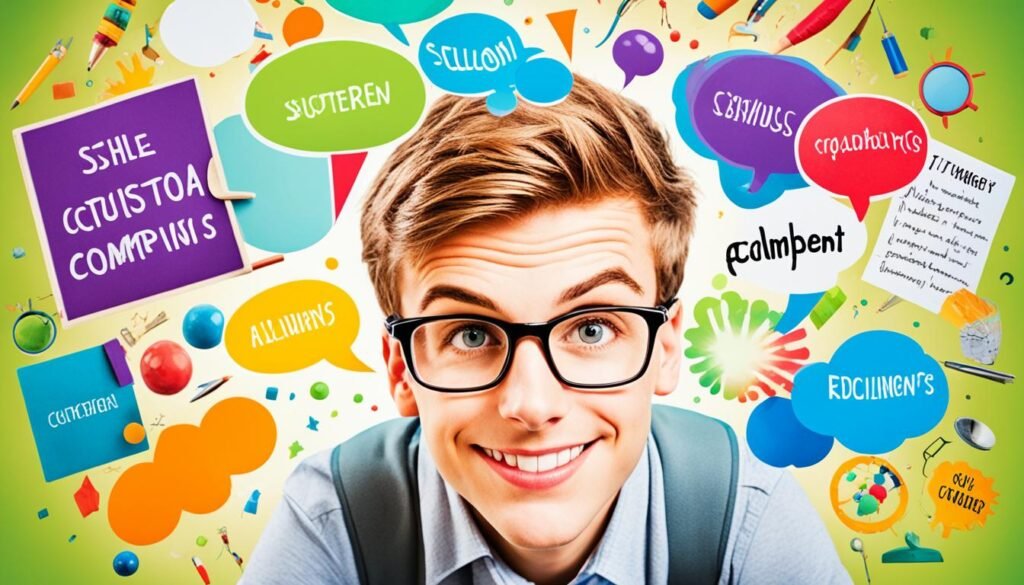
Embodied cognition changes how we think about education and learning. It shows how our bodies and minds work together. This idea helps teachers use physical activities to make learning deeper and more meaningful.
Studies on embodied cognition have become very popular. The article “Embodied Cognition: How Physical Experiences Shape Abstract Thinking” got 9940 reads and 62 references since 201725. It also has a score of 7 on Altmetric, showing its wide impact25.
Integrating Physical Experiences into Learning
Adding physical activities to learning can greatly improve how students understand and remember hard topics. Subjects like science, technology, engineering, and math are great for using embodied learning25. By doing hands-on tasks and using their senses, students can connect abstract ideas to real experiences.
There are studies that show how STEM education can benefit from this approach25. The theory of mathematical cognition by Grenzer and Walkington (2017) talks about how actions help us understand math better25.
Enhancing Cognitive Processes through Embodied Cognition
Embodied cognition helps improve how we think and learn. Research by Dove (2011) and Chatterjee (2010) shows that using our senses gives us solid information, while abstract thinking makes learning more flexible25. Finding a balance between these two is key to better learning.
Sheila L. Macrine and Jennifer M. B. Fugate have worked together to study how embodied cognition affects learning26. Their book, “Movement Matters: How Embodied Cognition Informs Teaching and Learning,” came out in 2022 and shares how to apply these ideas in class26.
Mindfulness, which focuses on being aware of our body and feelings, also uses the mind-body connection to improve learning. By noticing how we feel and what our body does, students can learn more about themselves and the world.
| Educational Practice | Embodied Cognition Principle | Potential Benefits |
|---|---|---|
| Hands-on learning activities | Engages sensory-motor experiences | Enhances understanding of abstract concepts |
| Mindfulness practices | Cultivates awareness of bodily sensations | Promotes emotional regulation and self-awareness |
| Embodied analogies in STEM | Translates sensorimotor actions into cognitive states | Supports mathematical understanding |
As we keep exploring embodied cognition’s effects on learning, we see big changes coming to education. By linking the mind and body and adding physical activities to learning, we can make education more effective and engaging.
Embodied Cognition and Social Perception

The idea of embodied cognition goes beyond just how we think inside our heads. It also looks at how our body affects how we see and connect with others27. Our body’s feelings and experiences change how we see and interact with people27.
One way our body affects social perception is through feeling warmth. Studies show that holding a warm drink or being in a cozy room makes us see others as friendlier and more trustworthy27. This shows how our body’s warmth can connect us to others.
“Warmth is the conduit of connection: it enhances and strengthens social bonds.” – Susan Pinker, psychologist and author
Embodied cognition also changes how we see others in many ways, not just through warmth. For example:
- Standing tall can make us feel more powerful and bold in social situations.
- Copying someone’s face and gestures can make us feel closer to them.
- Moving together, like dancing, can bring people closer and help them work together better.
Our body’s role in thinking, including social thinking, is important27. Different experts have different views on how the body affects our thoughts27.
Some theories say our body is more than just a place for our thoughts to happen28. The “4E cognition” idea looks at how our brain, body, and environment work together to shape our thoughts, including how we see others28.
Studying embodied cognition and social perception shows us how our body’s feelings deeply affect how we understand and connect with others. By seeing how our body influences our social life, we can better understand ourselves and others.
Challenges and Criticisms of Embodied Cognition
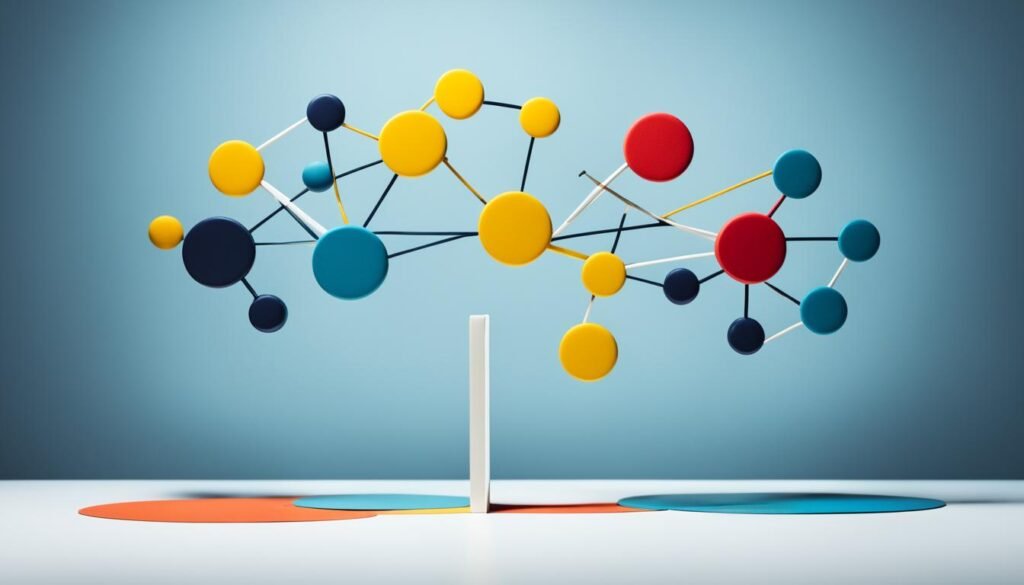
Embodied cognition has grown in interest, with over 15,000 books and articles since 200029. Yet, it faces challenges and criticisms. The term “embodied cognition” has become more popular in research, but its use has slowed down30. Researchers see challenges in defining and studying it30.
Some argue that embodied cognition shows a link between thoughts and actions but not that the body is key for thinking. Critics say the proof that our body helps our thinking is weak. They want stronger evidence to back up this idea29.
Arguments against the Necessity of Sensory-Motor Processes in Cognition
Researchers like Mahon and Caramazza have looked closely at how our body affects language. They found little strong proof that our body’s actions are needed for thinking29. Studies show that words about actions can make certain parts of the brain work. But, this doesn’t prove our body is crucial for thinking29.
Concerns Regarding the Groundedness of Abstract Concepts
Another issue is how abstract ideas fit into embodied cognition. Critics wonder how abstract thoughts can come from our body’s experiences. They question how abstract ideas can be linked to our body if they don’t have a clear physical link. This is a big challenge for embodied cognition theories.
Many have pointed out that embodied cognition lacks a clear theory30. It’s seen as a mix of different studies and ideas30. This diversity shows its wide reach but also the need for a unified theory.
Critics also suggest that embodied cognition needs clear, testable ideas. The push to make research broad might make it unclear30. Cognitive psychology has made progress by focusing on specific tasks30. Embodied cognition should aim for the same level of detail and testability in its theories and experiments.
| Criticism | Description |
|---|---|
| Necessity of Sensory-Motor Processes | Limited compelling evidence that sensory-motor processes are essential for cognition |
| Groundedness of Abstract Concepts | Difficulty in representing abstract concepts through sensory-motor simulations |
| Lack of Theoretical Coherence | Diverse collection of studies and theories under the same label |
| Need for Specific, Falsifiable Hypotheses | Systemic pressure to frame research in broad terms, leading to ambiguity |
Future Directions in Embodied Cognition Research
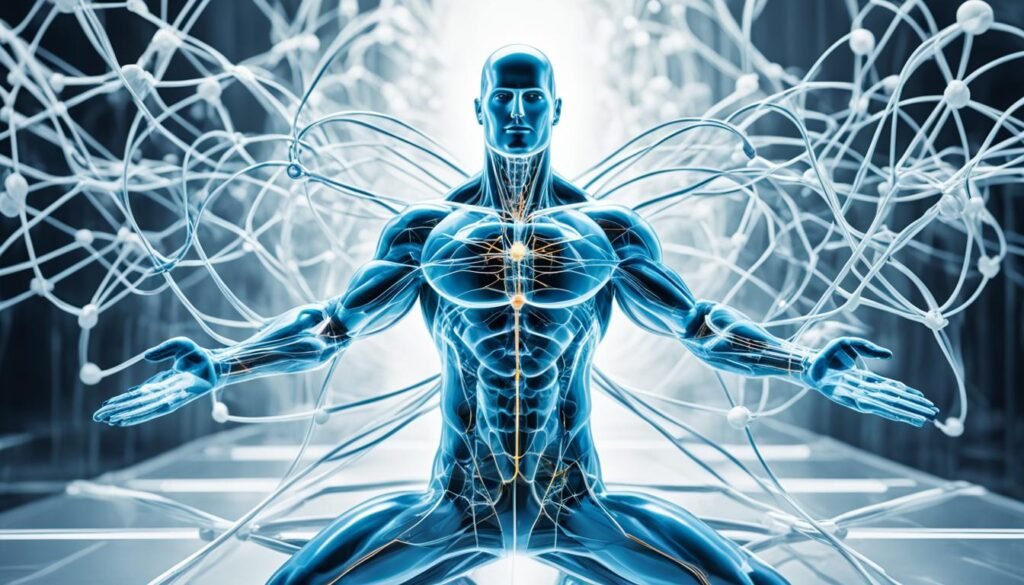
The study of embodied cognition is growing, and it’s key to focus on how our bodies affect our thinking and feelings. By looking into this, we can better understand how our physical actions shape our thoughts and feelings.
Specifying the Role of the Body in Cognitive Processes
Researchers need to figure out exactly how our bodies affect our thinking. They should look at how our body’s actions influence our thoughts at different times. For example, a study found that our brain’s motor areas start working 200–300 ms after we see something31.
This shows how our body’s actions affect our thinking right away. It also shows we need to learn more about this connection.
Future studies should focus on finding out which body processes help with different tasks. By understanding these processes, we can see how our body influences our thoughts. Studies have shown that our brain’s motor and touch areas work together when we process language31.
Investigating the Boundaries of Embodied Cognition
Embodied cognition has become more popular, but we need to know its limits. Researchers should find out how much our body’s actions are needed for different tasks. This will help us understand how embodied cognition works.
One way to do this is by seeing how our body’s actions affect our thinking. A study found that our body’s actions can cause small problems with understanding words, but bigger problems come from brain damage31. This shows that our body might be more important for some tasks than others.
It’s also important to think about the limits of the term “embodied cognition”. Some studies might not use this exact term but still talk about the topic32. Future research should look at these related ideas to get a full picture of how our body and mind work together.
By focusing on how our body affects our thinking and understanding its limits, we can learn more about embodied cognition. This will help us in many areas, like education, therapy, and designing better technology.
Conclusion
The idea of embodied cognition has changed how we see the link between our minds and bodies. It shows that our physical experiences deeply shape our thinking and mental processes. Research and experiments have shown that our body’s actions and senses play a big part in how we think33. Studies prove that our senses and muscles work together even when we’re just thinking34.
This idea has a lot of support, but it also faces some challenges. Some say our body’s actions might not fully explain how we think33. Other studies show that losing a sense or a limb doesn’t always affect our thinking34. Also, it might be hard to apply this idea to complex ideas like justice or beauty34. Yet, the idea of embodied cognition is used in many areas of thinking33. It looks at how our brain, body, and environment help us solve problems35.
Looking into grounded cognition is exciting, but we need to learn more about how it works and its limits. By studying how our brain, body, and environment work together, we can understand better how we think and act35. We should keep researching how our body affects our thinking and what it can’t do. This could lead to new ideas in education, psychology, and how we interact with computers.
FAQ
What is embodied cognition?
Embodied cognition looks at how our bodies help us think and learn. It says our physical body plays a big part in our mental abilities. This view challenges old ideas about how our minds work.
How does embodied cognition differ from traditional views of cognition?
Old views of cognition saw the mind as a computer in our brain. Embodied cognition says this isn’t the whole story. It draws from different areas to show how our body and environment shape our thoughts.
What is the role of the sensory-motor system in embodied cognition?
The sensory-motor system in our brain is key to embodied cognition. It brings back past experiences through sensory-motor simulation. This helps ground our thoughts and actions in reality.
How are abstract concepts grounded in concrete experiences?
Abstract ideas, like “democracy,” have roots in our sensory-motor system. They come from our personal experiences, like voting. We understand them better through metaphors tied to real-life experiences.
What are orientational metaphors, and how do they relate to embodied cognition?
Orientational metaphors give abstract concepts a spatial feel. For example, “more is up” comes from stacking items vertically. Some metaphors, like “power is up,” link to our experiences of the world.
How does embodied cognition influence our understanding of emotions?
Embodied cognition shows how our body affects our emotions. For instance, moving marbles up or down can bring back positive or negative feelings. This links our emotions to physical actions.
Can cultural differences affect embodied cognition?
Yes, culture shapes how we think about abstract ideas. For example, Mandarin speakers use vertical terms for time. This shows how language and culture influence our thoughts.
What role do gestures play in embodied cognition?
Gestures help us understand and remember things better. They make it easier to grasp ideas and remember them. Our body and mind work together closely in cognition.
How does posture affect cognitive processes?
Our posture can change how we think and feel. Open postures help us focus and feel confident. This shows how our body and mind interact deeply.
What are the implications of embodied cognition for learning and education?
Embodied cognition can improve learning and teaching. Adding physical activities to learning boosts our cognitive abilities. Mindfulness practices that focus on the body can also enhance learning.
What are some challenges and criticisms faced by embodied cognition?
Embodied cognition faces challenges and doubts. Some say it just shows thoughts and actions are linked, not that the body is key to thinking. Others question how abstract ideas fit into sensory-motor simulations. Critics want more specific research.
What should future research in embodied cognition focus on?
Future research should explore how the body affects thinking and learning. It’s important to understand when and how embodiment happens. Studying the limits of embodied cognition is key to advancing the field.



